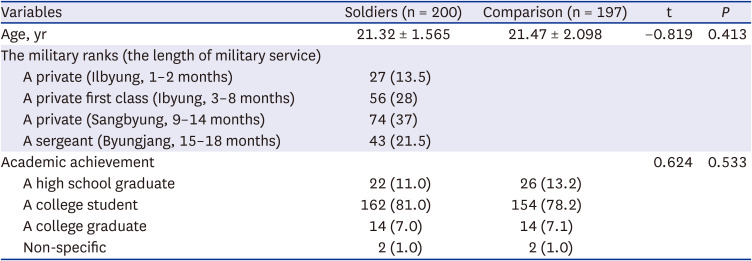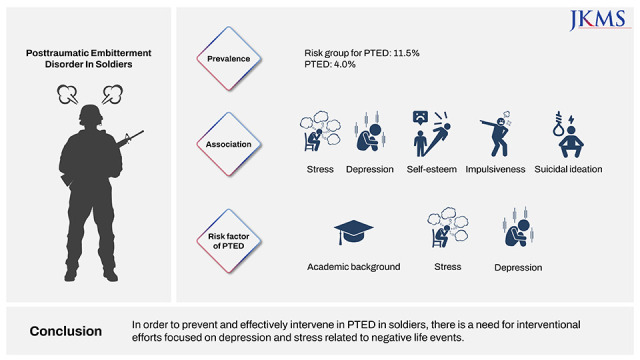1. Ministry of National Defense. National Defense Statistical Yearbook. Seoul, Korea: Ministry of National Defense;2020.
2. National Human Rights Commission. A Study on the Improvement of the Military Service System. Seoul, Korea: National Human Rights Commission;2016.
3. Kang SR, Ko JW, Kim YJ. Development of the Stress Diagnostic Scale on samples of Korean military personnel. Korean J Psychol Gen. 2012; 31(2):345–367.
4. Jackson PB, Finney M. Negative life events and psychological distress among young adults. Soc Psychol Q. 2002; 1(2):186–201.
5. Linden M. Posttraumatic embitterment disorder. Psychother Psychosom. 2003; 72(4):195–202. PMID:
12792124.
6. You M, Ju Y. Modeling embitterment dynamics: the influence of negative life events and social support mediated by belief in a just world. J Affect Disord. 2020; 274:269–275. PMID:
32469815.
7. Ku SS. Study for the problem of soldiers’ mental health and the state of military counseling services. Korean J Couns Psychother. 2013; 4(1):1–20.
8. Pflanz S. Occupational stress and psychiatric illness in the military: investigation of the relationship between occupational stress and mental illness among military mental health patients. Mil Med. 2001; 166(6):457–462. PMID:
11413719.
9. An HJ, Kwon SC, Kim HM. Factors that influence non-combat military soldiers’ suicidal ideation. J Korean Acad Psychiatr Ment Health Nurs. 2010; 19(3):299–306.
10. Kim SA, Kim HL, Woo CH, Park SI, Keum R. Communication abilities, interpersonal relationship, anxiety, and depression in Korean soldiers. J Korean Acad Psychiatr Ment Health Nurs. 2011; 20(1):81–90.
11. Kim SA, Kim HL, Keum R, Noh DB. Factors affecting on suicidal ideation in maladjusted soldiers. J Korean Acad Psychiatr Ment Health Nurs. 2013; 22(2):117–127.
12. Yu JH, Yun SK, Kim SJ, Hahm BJ, Cho IH, Kim JH, et al. Prevalence and correlates of suicide-related behaviors of army personnel. J Korean Assoc Soc Psychiatry. 2009; 14(1):12–17.
13. Ministry of Health and Welfare. Epidemiological Survey on Mental Illness in 2011. Sejong, Korea: Ministry of Health and Welfare;2011.
14. Park YJ, Chung WC. A study on factors in military adjustment of generation soldiers. Soc Sci Res Rev. 2006; 22(2):73–93.
15. Linden M, Baumann K, Rotter M, Schippan B. The psychopathology of posttraumatic embitterment disorders. Psychopathology. 2007; 40(3):159–165. PMID:
17318008.
16. Chung MK, Ko KS. The effect of soldiers’ self-esteem and depression on suicidal ideation: verifying mediation effect of depression. Korean J Soc Welf Stud. 2009; 40(4):453–483.
17. Kim Y, Baik SY, Jin MJ, Choi KH, Lee SH. The mediating effect of embitterment on the relationships between anxiety, depression, and suicidality. Psychother Psychosom. 2020; 89(6):395–397. PMID:
32208392.
18. Chae JH, Huh HJ, Choi WJ. Embitterment and bereavement: the Sewol ferry accident example. Psychol Trauma. 2018; 10(1):46–50. PMID:
29323525.
19. Linden M, Baumann K, Lieberei B, Rotter M. The Post-Traumatic Embitterment Disorder Self-Rating Scale (PTED Scale). Clin Psychol Psychother. 2009; 16(2):139–147. PMID:
19229838.
20. Shin C, Han C, Linden M, Chae JH, Ko YH, Kim YK, et al. Standardization of the Korean version of the Posttraumatic Embitterment Disorder Self-Rating Scale. Psychiatry Investig. 2012; 9(4):368–372.
21. Ko KB, Park JK, Kim CH. Development of the Stress Response Inventory. J Korean Neuropsychiatr Assoc. 2000; 39(4):707–719.
22. Lee YH, Song JY. Study of the reliability and the validity of the BDI, SDS, and MMPI-D Scales. Korean J Clin Psychol. 1991; 10(1):98–113.
23. Lee YH. The relations between attributional style, life events, event attribution, hopelessness and depression [dissertation]. Seoul, Korea: Seoul National University;1993.
24. Lee HS. Impulsiveness Test. Seoul, Korea: Guidance;1992.
25. Lee HS, Kwon JH. Validation for the Beck Scale for Suicide Ideation with Korean university students. Korean J Clin Psychol. 2009; 28(4):1155–1172.
26. Lee SH, Jeon SW, Yoon SY, Shin CM, Ko YH, Kim YK, et al. Posttraumatic embitterment disorder in Korean population: demographic characteristics and relationship with depression. Mood Emot. 2017; 15(2):78–84.
27. Lee JH, Kim S. Exposure to negative life events and post-traumatic embitterment symptoms in young adults in Korea: cumulative and differential effects. Psychopathology. 2019; 52(1):18–25. PMID:
30844818.
28. Joe S, Lee JS, Kim SY, Won SH, Lim JS, Ha KS. Posttraumatic embitterment disorder and hwa-byung in the general Korean population. Psychiatry Investig. 2017; 14(4):392–399.
29. Yoo BK, Lim KY. Comparison analysis of psychopathology between soldiers admitted for adjustment disorder and normal soldiers. J Korean Assoc Soc Psychiatry. 2005; 10(2):109–116.







 PDF
PDF Citation
Citation Print
Print





 XML Download
XML Download